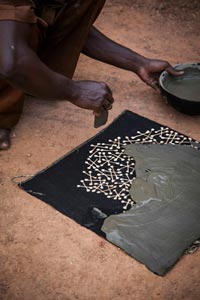The designers experimenting with textiles in west Africa

Simply sign up to the Life & Arts myFT Digest -- delivered directly to your inbox.
With the global demand for African art and music steadily rising, it is no surprise that design from around the continent is also making an impact. West African textiles, in particular, are beginning to appear in both the UK and US markets as the appetite for high-quality and sustainable products continues to grow on both sides of the Atlantic. In recent years African fabrics, with their hand made and low-impact origin, have been increasingly making their way into designer collections as well as high street shops.
“Young designers are experimenting with west African fabrics, and fashion designers like Matthew Williamson and Kenzo have launched collections using the material,” says Eva Sonaike (evasonaike.com), a London-based designer of Nigerian heritage whose collection includes cushions (£75) and pouffes (£399), all covered in original fabric inspired by west African wax cloth. “I think it is part of a broader west African creative renaissance: the region’s design, music, fashion and films are attracting interest and drawing in people from all over the world.”
Retailers are also sitting up and taking notice. London boutique Darkroom (darkroomlondon.com) has launched African collections, including cushions made of Ghanaian fabric, and high street retailer Habitat (habitat.co.uk) is set to launch a textile collection with Malian-made designs in September.
“In the UK it’s very easy for textiles to be Asia-centric,” says Rebecca Hoyes, a senior designer at Habitat. “But it’s an oversaturated market and we were interested in finding new approaches and designs.”
To develop the collection, Hoyes travelled to Burkina Faso and collaborated with Malian textile designer Boubacar Doumbia (ndomo.net). The pair experimented with the traditional bogolan technique, which involves colouring cloth with natural plant-based dyes, hand-painting designs and then covering it with mud from the Niger river to draw out the distinctive black, ochre and white colours.
“My role was to ensure we delivered a contemporary aesthetic and a more graphic quality within this traditional method,” says Hoyes. “Traditionally, bogolan patterns reflect tribal life in Mali so I came up with more urban motifs that reflect life here, such as one inspired by road markings.”
From the kente cloth of Ghana to the adire fabric of Nigeria, African textiles are hugely varied and play an integral role in daily life. Patterns are infused with meaning, while textiles are given as gifts at births and weddings, and used in many ceremonial exchanges. Their origin is similarly diverse, some made from plant fibres, sheep’s wool, camel hair, as well as the bark of trees.
In Europe, it is often the brightly coloured wax fabric that is most associated with the African textile industry. Originally Dutch in design, the fabric was in fact made for Indonesian markets but found a more enthusiastic audience in the Gold Coast (modern day Ghana), where it became fashionable and a symbol of quality. Up until the 1960s, most wax prints sold in west Africa were produced in Europe but in the postcolonial era, local manufacturing has become more common, with Ghana now home to several high-quality wax print manufacturers.
Johanna Bramble is a French weaver and textile designer who has lived in Dakar, Senegal, for the past five years (johannabramble.wix.com/creations). She creates textiles for interiors (her cushions retail at £60) and works on commission with architects and designers around the world. Bramble was drawn to Dakar by the country’s expertise in weaving and textile design.

“When I came to Senegal I found this long history of textile design that was really interesting and exciting and presented a lot of opportunities,” she says. “The Senegalese weaving technique is virtually unique in the world today. Its greatest feature is that it requires the presence of two people and this enables very elaborate and complex patterns to be woven.”
Aissa Dione (aissadione.net) is another Dakar-based textile designer who set up her own company, in part to help preserve traditional skills. “Weaving skills were being lost as imported fabrics grew in popularity,” says Dione, who worked with weavers to update designs and instigated a widening of the traditional loom to weave broader pieces of cloth.
She focuses on the high-end of the market and mostly uses organic cotton, hand-spun threads and natural dyes in her products. The luxurious feel and sustainable heritage of her collection has attracted upscale brands such as Hermes and Moroso, as well as designers including Christian Liaigre and Rose Tarlow. Today her company employs more than 100 local workers, largely in weaving but also in other disciplines including tailoring and embroidery.
African textiles may be in higher demand but local designers face concerns around production and a shortage of raw materials. According to a UN special report published in 2011, 5 per cent of the world’s cotton is grown in Africa but the continent commands 13 per cent of the world’s export market because the cotton is mainly grown as an export crop.
“The raw material just isn’t available any more,” says Dione. “Spinning and textile industries have nearly all closed and traditional weavers are slowly but surely disappearing. It’s a huge paradox. While millions of tons of cotton are being grown in west Africa, you can barely find a metre of finished textiles.”
While the hand-finished element of west African textiles contributes to their appeal, it can cause problems for large high street brands. “In a handmade mud cloth, for example, colour leaches and consistency varies, but high street retailers like us have to meet very high standards around product quality and consistency,” says Hoyes.
But it is likely that more retailers and designers will find a way to circumvent these problems as interest in west African textiles continues to rise. Designers across the region are also keen to play their part by experimenting with traditional patterns and approaches and updating their production methods.
Comments